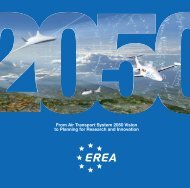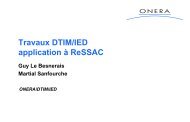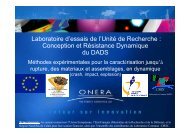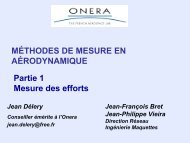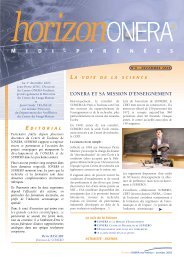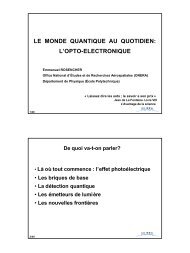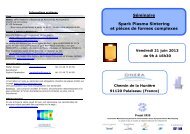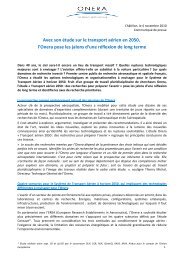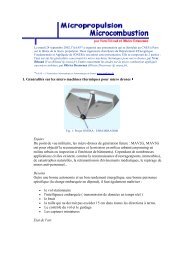Outline Introduction (en français / in french) Ramjet Scramjet ... - Onera
Outline Introduction (en français / in french) Ramjet Scramjet ... - Onera
Outline Introduction (en français / in french) Ramjet Scramjet ... - Onera
You also want an ePaper? Increase the reach of your titles
YUMPU automatically turns print PDFs into web optimized ePapers that Google loves.
Cet exposé a été donné à l'occasion du colloque "Chimie et Propulsions" organisé par la Fondation de la<br />
Maison de la Chimie à Paris le 20 mars 2002.<br />
• Paul Ku<strong>en</strong>tzmann est directeur sci<strong>en</strong>tifique<br />
de la branche Mécanique des Fluides et Energétique de l'ONERA<br />
• François Falemp<strong>in</strong> est responsable adjo<strong>in</strong>t<br />
du Départem<strong>en</strong>t Technique Vecteurs et Propulsion à MBDA France<br />
<strong>Ramjet</strong> ou statoréacteur<br />
<strong>Scramjet</strong> ou superstatoréacteur<br />
PDE = Pulse(d) Detonation Eng<strong>in</strong>e ou moteur à onde de détonation pulsée<br />
Les autres <strong>in</strong>terv<strong>en</strong>tions du colloque "Chimie et Propusions" sont disponible sur le site du colloque.<br />
<strong>Outl<strong>in</strong>e</strong><br />
<strong>Introduction</strong> (<strong>en</strong> français / <strong>in</strong> fr<strong>en</strong>ch)<br />
<strong>Ramjet</strong><br />
<strong>Scramjet</strong><br />
PDE<br />
Conclusions<br />
The <strong>Ramjet</strong> Pioneers (1913-1947)<br />
• R<strong>en</strong>é LORIN, FR (pat<strong>en</strong>t, 1913)<br />
• Albert FONO, GE (pat<strong>en</strong>t, 1928)<br />
• M. STECHKIN, SSSR (ramjet theory, 1929)<br />
• R<strong>en</strong>é LEDUC, FR (pat<strong>en</strong>t, 1933)<br />
• Other contributions :<br />
o FR : Marcel WANNER, Maurice ROY, Georges BRUN<br />
o GE : Eug<strong>en</strong> SÄNGER, Alexander LIPPISCH, O. PABST, M.
o<br />
o<br />
o<br />
TROMMSDORFF, H. WALTER<br />
SSSR : MM. BONDARYUK, DUDAKOV, MERKULOV,<br />
POBEDONOSTSEV, TSANDER, ZOUYEV<br />
UK : BRISTOL<br />
USA : Roy MARQUARDT, APL/JHU<br />
The Fr<strong>en</strong>ch word "statoréacteur" has be<strong>en</strong> created <strong>in</strong> 1945 by Maurice ROY (before :<br />
"trompes ou tuyères thermopropulsives"). The British adopted "Athodyd"<br />
(AeroTHermODYnamic Duct) before us<strong>in</strong>g ramjet. In Germany ramjet has be<strong>en</strong> called<br />
"Lor<strong>in</strong>flugrohr" or "Staustrahltriebwerke". In SSSR, ramjet was named PVRD.<br />
Some Refer<strong>en</strong>ces Relat<strong>in</strong>g to <strong>Ramjet</strong>/<strong>Scramjet</strong><br />
• Books :<br />
o Aircraft and Missile Propulsion, Vols I and II, M.J. Zucrow, John Wiley, C.<br />
Son, Inc., 1958<br />
o Aircraft Propulsion, P.J. Mc Mahon, Harpert Row, 1971<br />
o The Rocket <strong>Ramjet</strong> Reader, CSD/UTC, ~ 1980<br />
o Hypersonic Airbreath<strong>in</strong>g Propulsion, W.H. Heiser, D.T. Pratt, AIAA<br />
Education Series, 1994<br />
o Some Fundam<strong>en</strong>tals on the Performance of <strong>Ramjet</strong>s with Subsonic and<br />
Supersonic Combustion, TNO Pr<strong>in</strong>ts Maurits Laboratory, 2000<br />
• Rec<strong>en</strong>t Fr<strong>en</strong>ch Articles :<br />
o Statoréacteurs et superstatoréacteurs, A. Chevalier, Sci<strong>en</strong>ce et Déf<strong>en</strong>se, 1993<br />
o Statoréacteurs et superstatoréacteurs, des moteurs pour dema<strong>in</strong>, A. Chevalier,<br />
Sci<strong>en</strong>ce et Déf<strong>en</strong>se, 1995<br />
o Le statoréacteur, technologie d'av<strong>en</strong>ir, F. Falemp<strong>in</strong>, Colloque AAAF<br />
Aérodynamique et Propulsion des Véhicules à Grande Vitesse, 28-30 mars<br />
2001<br />
o <strong>Ramjet</strong>s et <strong>Scramjet</strong>s, B. Petit, Encyclopedia of Physical Sci<strong>en</strong>ce and<br />
Technology, Vol. 13, 2002<br />
o Les statoréacteurs <strong>en</strong> France (1913-1992), l'Aéronautique et l'Astronautique n°<br />
153, 1999/2<br />
Ma<strong>in</strong> Pr<strong>in</strong>ciple of the <strong>Ramjet</strong><br />
Basic design<br />
• The air <strong>in</strong>let/diffuser admits air to the <strong>en</strong>g<strong>in</strong>e, reduces air velocity and develops ram<br />
pressure.<br />
• The combustor adds heat and mass to the compressed air by burn<strong>in</strong>g a fuel. The
nozzle converts some of the thermal <strong>en</strong>ergy of the hot combustion products to k<strong>in</strong>etic<br />
<strong>en</strong>ergy to produce thrust.<br />
• Compression is giv<strong>en</strong> by the vehicle speed (bad performance at low speed, auxiliary<br />
bosster needed to reach <strong>in</strong>terest<strong>in</strong>g performances).<br />
• No mov<strong>in</strong>g parts, flexibility <strong>in</strong> geometrical design.<br />
• High thrust per unit frontal area.<br />
Flight Range of <strong>Ramjet</strong> Propelled Vehicles<br />
Consumption of air-breath<strong>in</strong>g <strong>en</strong>g<strong>in</strong>es (Pratt & Whitney)<br />
The hypersonic funnel (Mc Donnell Douglas)
The First Developm<strong>en</strong>ts and Applications (1945 to 1970)<br />
• Experim<strong>en</strong>tal vehicles and missiles (ma<strong>in</strong>ly with front air <strong>in</strong>take and jettisoned<br />
boosters)<br />
• Fr<strong>en</strong>ch achievem<strong>en</strong>ts (more than 200 flight tests) :<br />
o ONERA Stataltex : M=5 at 25000 m (1965), M=3,8 at 39000 m<br />
o Ars<strong>en</strong>al (>> SFECMAS >> Nord Aviation >> Aerospatiale >> EADS) and<br />
SNCASE (>> Sud Aviation >> Aerospatiale >> EADS)<br />
SE 4400 : M=3,7 at 22000 m (1957)<br />
CT41, M=3 at 23000 m<br />
VEGA, M=4,2 at 25000 m (1961)<br />
o MATRA, Snecma (ST 401, ST 402, ST 407)<br />
o Leduc and Griffon 2 (turboramjet)<br />
• SSSR : SA4 Ganef - SA6 Ga<strong>in</strong>ful (SAN3 Goblet) ; <strong>Ramjet</strong>s developed by NIITP ?<br />
• Swed<strong>en</strong> : RR2, RRX-1, RRX-5<br />
• UK : Bristol Siddeley Thor (Bloodhound) and Od<strong>in</strong> (Sea Dart)<br />
• USA :<br />
•<br />
o<br />
o<br />
o<br />
RJ30, 31, 34, 37, 43, 57, 59 (Marquardt)<br />
RJ55 (Curtiss Wright)<br />
CIM10A/B : Bomarc/Super Bomarc<br />
Some Poorly Known Achievem<strong>en</strong>ts<br />
• FR :<br />
o<br />
o<br />
SE X 422 (the first fr<strong>en</strong>ch cruise missile)<br />
ONERA SCORPION project (M6 missile)<br />
• SSSR : Burya 2 (<strong>in</strong>tercont<strong>in</strong><strong>en</strong>tal strategic missile)<br />
• USA : D21 (reconnaissance drone<br />
The SE X 422 Demonstrator<br />
• Prototype of a long range cruise missile<br />
• m T = 1900 kg ; Ø 500 mm liquid fueled ramjet<br />
• M = 2 dur<strong>in</strong>g 70 km<br />
• 3 successful tests <strong>in</strong> 1967 (Hammaguir and Levant Island)
The ONERA SCORPION Project<br />
Ref : Les <strong>en</strong>g<strong>in</strong>s à statoréacteur du Groupe Technique de Cannes,<br />
L. Trousse, L'Aéronautique et l'Astronautique, n° 153, 1999/2<br />
• SCORPION : Statoréacteur Cruciforme comme ORgane Portant Intégré à Orifices<br />
Nasaux<br />
• Prototype of a long range ground to air missile (M = 6, 600 km) ; Ø 220 mm liquid<br />
fueled ramjet (demonstrator)<br />
• Successful ground tests of the fully <strong>in</strong>tegrated vehicle <strong>in</strong> the S4 MA w<strong>in</strong>d tunnel<br />
(1973-1974)<br />
Operational lay-out<br />
Model for S4 w<strong>in</strong>d-tunnel test<strong>in</strong>g
The Russian Burya (storm) Missile<br />
• Developm<strong>en</strong>t of an <strong>in</strong>tercont<strong>in</strong><strong>en</strong>tal strategic missile, similar to the US XSM64<br />
Navaho (Lavotchk<strong>in</strong>, parallel developm<strong>en</strong>t Buran by Miassischev)<br />
• m T = 216 t (<strong>in</strong>clud<strong>in</strong>g the two keros<strong>en</strong>e/nitric acid fueled boosters) - Bondyaruk's<br />
ramjet RD012U, Ø 1700 mm<br />
• MMAX = 3,15 ; 8000 km expected range<br />
• 5 successful tests ; project cancelled <strong>in</strong> 1958<br />
Ref : Aviation Week and Space Technology, November 2, 1992, p. 50<br />
The Supersonic Reconnaissance Drone Lockheed D21 Tagboard<br />
• Black program ($2B) disclosed around 1990<br />
• m T = 5 t ; Marquardt RJ43MA11 JP7 fueled ramjet, Ø 711 mm<br />
o D21 : launched from a Lockheed M12 aircraft at high supersonic speed<br />
(programme cancelled <strong>in</strong> 1966 after a collision dur<strong>in</strong>g separation)<br />
o D21B : launched from a Boe<strong>in</strong>g B52 bomber with a booster<br />
• M MAX = 4 at 30000 m ; <strong>en</strong>durance 4 h at M = 3,8 and 24000 m<br />
• No recovery device<br />
Ladies <strong>in</strong> wait<strong>in</strong>g, a pictorial review of Davis Monthan AFB, S. Wonderly, C.R. Dunham, Squadron/Signal<br />
Publications, 1991
The Modern <strong>Ramjet</strong> for Missile Applications<br />
• Integrated booster: ejectable booster nozzle or nozzleless booster<br />
• Lateral air <strong>in</strong>take(s)<br />
• Flame stabilization by recirculation zones<br />
Thor ramjet (Bloodhound)<br />
Integrated rocket ramjet (S225XR project)<br />
Modern <strong>Ramjet</strong> Propelled Missiles<br />
• Air to air missiles<br />
o MBDA Meteor (developm<strong>en</strong>t)<br />
o Vympel RVV-AE-PD R77M (AA12 Adder, developm<strong>en</strong>t)<br />
o K<strong>en</strong>tron ?<br />
• Air to surface missiles<br />
o EADS/AMM<br />
ASMP<br />
ASMP-A (developm<strong>en</strong>t)<br />
o Radouga Kh41 Moskit<br />
o Zvezda Kh31P (AS17 Krypton)<br />
• Antiship missiles<br />
o Mach<strong>in</strong>ostro<strong>en</strong>ie 3K55 Yakhont (SSN26)<br />
o Radouga 3M80/82 Moskit (SSN22 Sunburn)<br />
o CPMEC C301 (coast to ship)
o Hsiung F<strong>en</strong>g 3<br />
• Surface to air missiles<br />
o MBDA<br />
Bloodhound Mk2<br />
Sea Dart<br />
A Classification of <strong>Ramjet</strong>s Accord<strong>in</strong>g to the Fuel<br />
• Pure fuel<br />
o gas (hydrog<strong>en</strong> : stored liquid but <strong>in</strong>jected gaseous after wall cool<strong>in</strong>g)<br />
o liquid or slurry<br />
LFRJ (Liquid Fuel <strong>Ramjet</strong>)<br />
o solid<br />
<strong>in</strong> bulk: SFRJ (Solid Fuel <strong>Ramjet</strong>)<br />
powdery<br />
• Solid propellant gas g<strong>en</strong>erator ? Ducted rocket (DR) or Ram rocket<br />
o Unchocked Flow<br />
UFDR<br />
o Chocked or Variable Flow<br />
VFDR<br />
The LFRJ<br />
ANNG Project<br />
• Liquid fuels<br />
o keros<strong>en</strong>es or synthetic hydrocarbon fuels<br />
Examples :<br />
USA :
o<br />
RJ1, RJ4 (tetrahydrodi (methycyclop<strong>en</strong>tadi<strong>en</strong>e)), RJ5<br />
(perhydrodi (norbornadi<strong>en</strong>e)), RJ6 (bl<strong>en</strong>d RJ5-JP10), RJ9<br />
- boranes (abandoned) .<br />
FR :<br />
CSD07T, CSD15T (developed and produced by IFP,<br />
derivatives of norbornadi<strong>en</strong>e)<br />
<strong>en</strong>dothermal fuels<br />
Example<br />
MCH<br />
Choice of the fuel is a compromise betwe<strong>en</strong> specific impulse Is, d<strong>en</strong>sity/volumic specific<br />
impulse (dIs), mixture ratio and possibly cool<strong>in</strong>g capability and crack<strong>in</strong>g properties.<br />
Combustion mechanisms : spray combustion<br />
RASCAL : RAmjet Small CALibre<br />
Use of a Slurry <strong>in</strong> the LFRJ<br />
• Keros<strong>en</strong>e + boron particles (50 to 70 % mass cont<strong>en</strong>t)<br />
• FR : CHEOPS program ; US programs ; Russian programs ?
The SFRJ<br />
• Solid fuels<br />
o Polymer possibly loaded with metal particles (Mg, Al or B)
• Combustion mechanisms : pyrolysis and diffusion flame<br />
• Good performance for high Mach number cruise but moderate variability of the fuel<br />
regression rate, hav<strong>in</strong>g an effect on the combustion chamber design ; self modulation<br />
of the fuel mass flow rate and of the mixture ratio<br />
• Limited number of applications<br />
The <strong>Ramjet</strong> Burn<strong>in</strong>g a Metal Powder<br />
• A concept born <strong>in</strong> Russia<br />
• A technology imported <strong>in</strong> France (ONERA) and successfully demonstrated at middle<br />
scale (Ø 200 mm)<br />
• Advantages : high performance, high d<strong>en</strong>sity, managem<strong>en</strong>t of a cool fuel, high<br />
modulation rate, relative <strong>in</strong>s<strong>en</strong>sivity of the load<strong>in</strong>g<br />
• Drawbacks: a secondary gaseous source (gas g<strong>en</strong>erator and cooler) is needed to<br />
fluidize the powder, preparation of the load<strong>in</strong>g and control of the flow rate are critical<br />
The Ducted Rocket (DR)<br />
• Pr<strong>in</strong>ciple :<br />
o A "gas" g<strong>en</strong>erator is provid<strong>in</strong>g the fuel species which are <strong>in</strong>jected <strong>in</strong> the ramjet<br />
combustion chamber (GFRJ)<br />
o The "gas" g<strong>en</strong>erator is work<strong>in</strong>g like a solid propellant rocket, except that the<br />
solid propellant has a low oxidizer cont<strong>en</strong>t<br />
o The "gas" g<strong>en</strong>erator products can conta<strong>in</strong> a high fraction of fuel particles (Mg,<br />
Al, B, C) to <strong>en</strong>hance the performances<br />
• The first operational missile us<strong>in</strong>g such a concept has be<strong>en</strong> the Russian SA6 Ga<strong>in</strong>ful<br />
(Mg). Work began <strong>in</strong> France at ONERA around 1972 (A. Moutet) and related
propellant activity was shared quickly with SNPE ("aerogols")<br />
• A large variety of composite propellants for DR is now available for missiles<br />
applications, for <strong>in</strong>stance :<br />
o propellants for "low" IR signature missiles ("aérolite")<br />
o high d<strong>en</strong>sity, high performance propellants ("aérofluolèbe")<br />
o propellants for VFDR and UFDR C<br />
• ombustion mechanisms are conv<strong>en</strong>tional one-phase or two-phase ones<br />
The VFDR<br />
• Throttl<strong>in</strong>g of the gas g<strong>en</strong>erator mass flow rate by variation of its throat, that gives a<br />
thrust modulation capability to the ramjet. But throttl<strong>in</strong>g of hot gases, possibly<br />
conta<strong>in</strong><strong>in</strong>g solid particles, is technically difficult<br />
• Solution adopted on the Meteor (BVRAAM) ramjet<br />
The UFDR<br />
- The Fr<strong>en</strong>ch "Rustique" Concept<br />
Source : PROTAC S.A.<br />
• No chocked throat betwe<strong>en</strong> the gas g<strong>en</strong>erator and the ramjet combustion chamber ;<br />
the gas g<strong>en</strong>erator solid propellant burn<strong>in</strong>g rate dep<strong>en</strong>ds on the combustion chamber<br />
pressure ; self-modulation of the mixture ratio can be obta<strong>in</strong>ed by giv<strong>in</strong>g a right value<br />
to the solid propellant pressure expon<strong>en</strong>t<br />
• Whole ramjet operation start<strong>in</strong>g from the nozzleless booster ignition order (munition<br />
style)<br />
• Concept successfully demonstrated <strong>in</strong> flight through the MPSR and MPSR2 programs<br />
(MATRA, ONERA, SNPE) ; no curr<strong>en</strong>t applications
Sci<strong>en</strong>tific Issues of <strong>Ramjet</strong><br />
• Air <strong>in</strong>takes : the design is critical (effici<strong>en</strong>cy on the whole flight range, s<strong>en</strong>sitivity to<br />
flow distorsions, participation to <strong>in</strong>stabilities)<br />
• Combustion chamber<br />
o combustion effici<strong>en</strong>cy<br />
o lean and rich stability limits<br />
o wall cool<strong>in</strong>g<br />
o operat<strong>in</strong>g <strong>in</strong>stabilities<br />
Combustion Effici<strong>en</strong>cy and Stability Limits<br />
• Combustion effici<strong>en</strong>cy and stability limits are dep<strong>en</strong>d<strong>in</strong>g on several parameters : fuel,<br />
equival<strong>en</strong>ce ratio, air stagnation pressure and temperature
• Experim<strong>en</strong>tal approach through tests : exp<strong>en</strong>sive<br />
• The ONERA's approach, the research ramjet :<br />
o a modular design reproduc<strong>in</strong>g the ma<strong>in</strong> features of an actual ramjet<br />
o the capability to get a detailed characterization of the reactive flow by us<strong>in</strong>g<br />
the most advanced optical diagnostics (LDV, LIF, PLIF…)<br />
o a tool for validation the 3D turbul<strong>en</strong>t reactive two phase flow codes (MBDA-<br />
ONERA)<br />
Combustion Chamber Wall Cool<strong>in</strong>g<br />
• Passive thermal protections<br />
o differ<strong>en</strong>t materials (silicone based) are available<br />
• Active thermal protection<br />
o a portion of the air flow <strong>en</strong>ter<strong>in</strong>g is bypassed to protect the case and is<br />
re<strong>in</strong>jected <strong>in</strong> the combustion chamber through perforations<br />
o compatibility with booster <strong>in</strong>tegration demonstrated ; concept rather<br />
<strong>in</strong>terest<strong>in</strong>g for combustion stability<br />
o solution limited to flight Mach number less than 4<br />
• Some successful developm<strong>en</strong>ts of all composite cases, application to ASMP-A<br />
Operat<strong>in</strong>g Instabilities<br />
• Differ<strong>en</strong>t types of <strong>in</strong>stability :<br />
o overall <strong>in</strong>stability <strong>in</strong>volv<strong>in</strong>g the air <strong>in</strong>take(s) : low/medium frequ<strong>en</strong>cy (100 to
300 Hz) ; g<strong>en</strong>erally cured by improv<strong>in</strong>g the air <strong>in</strong>take(s)<br />
o combustion chamber acoustical <strong>in</strong>stability : from medium to high frequ<strong>en</strong>cy ;<br />
the highest frequ<strong>en</strong>cies (tang<strong>en</strong>tial modes) are the most dangerous, <strong>in</strong>duc<strong>in</strong>g<br />
an accelerated consumption of the thermal protections<br />
• Ma<strong>in</strong>ly faced on LFRJ ; some <strong>in</strong>stabilities on DR connected to specific solid<br />
propellant combustion ph<strong>en</strong>om<strong>en</strong>a<br />
• Numerical prediction of ramjet <strong>in</strong>stabilities is not yet achieved. Differ<strong>en</strong>t solutions are<br />
however known to reduce or suppress the <strong>in</strong>stability levels, like :<br />
o geometrical devices : baffles, local caps<br />
o modification of the <strong>in</strong>jection devices or controlled distribution of the fuel<br />
• A compromise betwe<strong>en</strong> performance and <strong>in</strong>stability level is g<strong>en</strong>erally sought<br />
Some Unconv<strong>en</strong>tional Applications of <strong>Ramjet</strong><br />
• <strong>Ramjet</strong> propelled rotor<br />
• Integrated ramjet <strong>in</strong> w<strong>in</strong>g<br />
• RAMAC (RAM ACcelerator) : launch<strong>in</strong>g of a small mass at a very high speed from a<br />
tube (NASA, NLR, ISL)<br />
• <strong>Ramjet</strong> propelled shell<br />
• Nuclear ramjet : PLUTO US program (nuclear reactor TORY II C), cancelled <strong>in</strong> 1965<br />
; concept revisited <strong>in</strong> the USA ?<br />
• MHD ramjet : AJAX/NEVA project (L<strong>en</strong><strong>in</strong>etz)<br />
o a fasc<strong>in</strong>at<strong>in</strong>g concept, but beyond the pres<strong>en</strong>t technical possibilities<br />
Simplified scheme of scramjet<br />
with MHD control under « AJAX » concept<br />
From <strong>Ramjet</strong> to <strong>Scramjet</strong> (Supersonic Combustion <strong>Ramjet</strong> or SCRJ)<br />
• Beyond Mach = 5 (hypersonic doma<strong>in</strong>), ramjet is less and less effici<strong>en</strong>t. Increas<strong>in</strong>g of
air stagnation temperature and pressure t<strong>en</strong>ds to limit the performance and to <strong>in</strong>crease<br />
the thermal and mechanical loads on the combustion chamber walls<br />
• To bypass these issues, the solution is to ma<strong>in</strong>ta<strong>in</strong> the flow supersonic from the air<br />
<strong>in</strong>let to the <strong>en</strong>g<strong>in</strong>e exit and to achieve the combustion <strong>in</strong> the supersonic flow<br />
• A geometrical throat is therefore no longer needed to accelerate the flow and produce<br />
the thrust ; transition from subsonic to supersonic flow can also be achieved, without<br />
geometry variation, by heat addition<br />
• Two variants of scramjet :<br />
o pure scramjet<br />
o dual mode ramjet allow<strong>in</strong>g transition from subsonic to supersonic combustion<br />
The First <strong>Scramjet</strong> Developm<strong>en</strong>ts (1965-1975)<br />
• USA :<br />
o<br />
o<br />
Marquardt<br />
Garret Air Research HRE (Hypersonic Research Eng<strong>in</strong>e)<br />
scheduled to be tested on the X15-A2 aircraft<br />
f<strong>in</strong>ally only tested at ground around 1971<br />
• SSSR :<br />
o TsIAM s<strong>in</strong>ce 1957 (E.S. Chet<strong>in</strong>kov)<br />
o TsAGI, ITAM, MAI<br />
o no flight tests recorded<br />
• France (ONERA) :<br />
o ESOPE (Etude de Statoréacteur comme Organe de Propulseur Evolué)<br />
program<br />
o ground tests around 1972 at S4MA w<strong>in</strong>d tunnel<br />
• Common features betwe<strong>en</strong> HRE and ESOPE :<br />
o Hydrog<strong>en</strong>-fueled scramjets<br />
o axisymmetric combustion chamber, frontal c<strong>en</strong>tral body<br />
o ground tests at simulated Mach number 5,5 to 7,4
The R<strong>en</strong>ewal of <strong>Scramjet</strong> (1988-?)<br />
Dual mode ramjet operation<br />
• Two tr<strong>en</strong>ds for the applications :<br />
o hypersonic missiles (see AGARD Aerospace 2020 report)<br />
o reusable airbreath<strong>in</strong>g launchers (NASP project for <strong>in</strong>stance<br />
• A lot of new developm<strong>en</strong>ts :<br />
o USA (NASA, Air Force) : the HyXXX programs : HyStep, Hyper X/X43A<br />
(one attempt of flight), HyTech (X43C), HySet...<br />
o SSSR th<strong>en</strong> Russia : the Kholod test flights (1991-1998), Igla project…<br />
• France : PREPHA program, jo<strong>in</strong>t ONERA-DLR JAPHAR program, DGA<br />
PROMETHEE program, developm<strong>en</strong>ts MBDA/MAI<br />
• Germany : MTU, DLR/TsAGI<br />
• Japan : NAL<br />
• Ch<strong>in</strong>a : Institute of Mechanics, Ch<strong>in</strong>ese Academy of Sci<strong>en</strong>ces
• Australia (University of Que<strong>en</strong>sland and International cooperation) : HyShot program<br />
(one attempt of flight)<br />
Up to now, no scramjet propelled vehicle had a free flight allow<strong>in</strong>g a drag-thrust balance<br />
estimation<br />
The Fuel Issues<br />
• Hydrog<strong>en</strong> has be<strong>en</strong> selected for the first ground or flight demonstrations from <strong>en</strong>ergy<br />
considerations : high <strong>en</strong>ergy cont<strong>en</strong>t, high capability of cool<strong>in</strong>g, fast combustion after<br />
mix<strong>in</strong>g with air. However hydrog<strong>en</strong> has two drawbacks for the applications : it should<br />
be stored liquid at very low temperature (~ 20 K) and its d<strong>en</strong>sity is very low (~ 0,07)<br />
o rejected for military applications<br />
o design of a SSTO reusable space launcher seems difficult<br />
• Hydrocarbons have a lower <strong>en</strong>ergy cont<strong>en</strong>t than hydrog<strong>en</strong> and should face other issues<br />
related to <strong>in</strong>jection, combustion… They can also be used to cool the structure through<br />
their <strong>en</strong>dothermal properties<br />
• Other concepts :<br />
o dual fuel scramjet<br />
o solid fuel scramjet<br />
o methane reform<strong>in</strong>g (AJAX concept, L<strong>en</strong><strong>in</strong>etz, Russia)<br />
The "best" fuel will dep<strong>en</strong>d on the considered application and its selection will be the result of<br />
heavy system studies<br />
The Ground Test Facilities<br />
• Simulation of the high Mach number flight conditions (stagnation pressure and<br />
temperature) requires powerful and exp<strong>en</strong>sive facilities. The world operational<br />
facilities are limited to Mach = 8<br />
• Three solutions to heat air, which can be comb<strong>in</strong>ed :<br />
o pebble bed heater hydrog<strong>en</strong>-air<br />
o combustion and oxyg<strong>en</strong> addition (air viciated by water vapor)<br />
o production of synthetic air<br />
• Other solutions can be considered from hypersonic w<strong>in</strong>d tunnels, but only for very<br />
short test time<br />
• The most powerful facilities (high mass flow rates) are located <strong>in</strong> the USA and <strong>in</strong><br />
Russia<br />
• Some rec<strong>en</strong>t and high performance facilities developed <strong>in</strong> :<br />
o Germany : MTU, DLR<br />
o Japan : NAL Kakuda<br />
o France : MBDA l<strong>in</strong>e 4 (Subdray), ONERA LAERTE and ATD5 facilities
• An impressive US project : MARIAH (Magnetohydrodynamic Accelerator Research<br />
Into Advanced Hypersonics) : Pr<strong>in</strong>ceton, Sandia, Livermore, MSE Technology<br />
Application, M = 15, 10 s !<br />
Rec<strong>en</strong>t Fr<strong>en</strong>ch Achievem<strong>en</strong>ts and Projects<br />
• Ground test of a dual mode H2 fueled ramjet with a fixed geometry (ONERA,<br />
JAPHAR program, M = 4 to 8)<br />
• Developm<strong>en</strong>t of the WRR (Wide Range <strong>Ramjet</strong>), a dual fuel dual mode ramjet, with a<br />
variable geometry, first ground tests on the demonstrator PIAF <strong>in</strong> May 2002 (MBDA<br />
and MAI, M = 3 to 12)<br />
• MBDA and ONERA are work<strong>in</strong>g on the scramjet of the PROMETHEE program : dual<br />
mode, <strong>en</strong>dothermal hydrocarbon-fueled scramjet, M = 2 to 8 (tests <strong>in</strong> 2002)<br />
Pressure<br />
Mach<br />
number<br />
H 2 O
From <strong>Ramjet</strong> to PDE<br />
• <strong>Scramjet</strong> us<strong>in</strong>g a detonation wave (ODWE)<br />
o concept considered by several teams (Canada, France) for M > 10, no<br />
experim<strong>en</strong>tal demonstration<br />
• Pulsed combustion already considered :<br />
o operational on pulsed jet (acoustically tuned chamber) :<br />
Argus (Fieseler V1), mechanically valved type<br />
Escopette (Snecma, 50's), valveless type<br />
OKB Sokol and ENICS (Kazan, Russia)<br />
o considered for turbojet combustion chamber (Snecma, 50's)<br />
o considered for ramjet :<br />
DSI resonat<strong>in</strong>g ramjet : one flight test ? (USA, 1976)<br />
Technion project : ISABE 93-7038 (Israël, 1993)<br />
• PDE :<br />
o<br />
o<br />
comb<strong>in</strong>es pulsed combustion and detonation<br />
is not a conv<strong>en</strong>tional pulsed jet : ignition is controlled<br />
A Family of Concepts<br />
• PDE = PDWE (Pulsed Detonation Wave Eng<strong>in</strong>e)<br />
• PDRE = Pulsed Detonation Rocket Eng<strong>in</strong>e<br />
• RVSPDE = Rotary Valved S<strong>in</strong>gle PDE (ASI's concept)<br />
• RVMPDE = Rotary Valved Multiported PDE (ASI's concept)<br />
Airbreath<strong>in</strong>g PDE is known as PDE<br />
Some Refer<strong>en</strong>ces Relat<strong>in</strong>g to PDE<br />
Reports and papers<br />
• Buss<strong>in</strong>g, Pappas : Pulse Detonation Eng<strong>in</strong>e theory and concepts, AIAA Progress <strong>in</strong><br />
Aeronautics and Astronautics, 1995<br />
• NPGS reports (experim<strong>en</strong>ts and theoretical analysis)<br />
• NASA CR 187137 and AIAA 92-3174 (ISTAR Inc., CSTU Fullerton, NASA Lewis) :<br />
Detonation Duct Gas G<strong>en</strong>erator Demonstration Program<br />
• SAIC : AIAA 89-2446, AIAA 90-0460, AIAA 90-2420, AIAA 92-0392, AIAA 92-<br />
3168 (Eidelmann et al., computational analysis, PDE located <strong>in</strong> a w<strong>in</strong>g section)<br />
• ASI : AIAA 97-2742, AIAA 97-2743 (Buss<strong>in</strong>g, Bratkovich et al., experim<strong>en</strong>ts and
technologies)<br />
• LCD/CNRS Poitiers : 21th ISSW 1997, CST 1999 (Zitoun, Desbordes, experim<strong>en</strong>ts on<br />
CnHm-O2 mixtures and theoretical analysis)<br />
• CELERG <strong>in</strong>ternal reports (experim<strong>en</strong>ts and technologies)<br />
• ONERA <strong>in</strong>ternal reports (computational analysis)<br />
• MBDA : AIAA 00-3341, AIAA 01-3815<br />
Rec<strong>en</strong>t programs<br />
• USAF SBIR (Small Bus<strong>in</strong>ess Innovation Research)<br />
• NASA REVCON (REVolutionary CONcept)<br />
• DGA PEA POD<br />
Ma<strong>in</strong> Pr<strong>in</strong>ciple of PDE<br />
Constant volume combustion is more effici<strong>en</strong>t than constant pressure combustion, as<br />
demonstrated by a cycle analysis<br />
Constant pressure (Brayton cycle : 1-2-5-6-1)<br />
Constant volume (Humphrey cycle : 1-2-3-4-1)
dep<strong>en</strong>ds on<br />
and on the pressure ratio<br />
A performance ga<strong>in</strong> is expected beside the conv<strong>en</strong>tional <strong>en</strong>g<strong>in</strong>es<br />
Theoretical ga<strong>in</strong> for the rocket version : 5 to 10 % i.e.<br />
Operation possible at rest<br />
Sequ<strong>en</strong>tial View of the PDRE Operat<strong>in</strong>g Cycle
The Airbreath<strong>in</strong>g PDE<br />
Ref : Aviation Week and Space Technology, July 17, 2000<br />
Bigger : 104 Ko<br />
Remark : O2 is added to facilitate the detonation<br />
ASI's Six Combustor PDRE on the Test Stand<br />
Experim<strong>en</strong>tal Results<br />
Ref : Aviation Week and Space Technology, July 17, 2000
Elem<strong>en</strong>tary cycle LCD/CNRS Poitiers<br />
ASI PDRE<br />
ASI RVMPDE<br />
Computational Results<br />
Comparison betwe<strong>en</strong> PDE and PDRE (prelim<strong>in</strong>ary results)
Op<strong>en</strong> air <strong>in</strong>take Pressure (Pa) Closed air <strong>in</strong>take<br />
• CELERG configuration, hydrog<strong>en</strong>/oxyg<strong>en</strong>/air, one cycle<br />
• ONERA computation, MSD code, axisymmetrical flow description<br />
Claimed PDE/PDRE Advantages and Key Issues<br />
Claimed advantages<br />
• No mov<strong>in</strong>g parts<br />
• High thermodynamic effici<strong>en</strong>cy<br />
• Operat<strong>in</strong>g <strong>in</strong> a pot<strong>en</strong>tial large Mach number range (from 0 to 4-5)<br />
• Simplicity and flexibility of geometrical configuration<br />
• Easy <strong>in</strong>tegration to the vehicle<br />
• Low cost<br />
Key issues<br />
• Detonation <strong>in</strong>itiation (PDE/PDRE)<br />
• Air <strong>in</strong>let design (PDE)<br />
• Fuel/air <strong>in</strong>jection and mix<strong>in</strong>g (PDE/PDRE)<br />
• Coupl<strong>in</strong>g with external flow (PDE)<br />
• Design optimization (PDE/PDRE)<br />
Pot<strong>en</strong>tial PDE Applications<br />
• Low cost and effici<strong>en</strong>t vehicles for military applications<br />
o target and research drones<br />
o p<strong>en</strong>etration aids devices<br />
o "smart" missiles<br />
• Acceleration <strong>en</strong>g<strong>in</strong>es (for ramjet) ?<br />
• Ma<strong>in</strong> <strong>en</strong>g<strong>in</strong>e for high supersonic aircraft ("Aurora" controversy) ??
• Stages of space launcher (PRDE) ?<br />
Conclusions<br />
• <strong>Ramjet</strong> technology is now mature<br />
o the ma<strong>in</strong> applications are military<br />
o turboramjet has a pot<strong>en</strong>tial for high supersonic or hypersonic transportation<br />
• <strong>Scramjet</strong> technology still needs heavy developm<strong>en</strong>ts<br />
o military applications are considered<br />
o a pot<strong>en</strong>tial for future RLV<br />
• PDE looks attractive for special missions but is not yet totally mastered<br />
• Future of ramjet/scramjet technology implies coupl<strong>in</strong>g of differ<strong>en</strong>t thermodynamic<br />
cycles (hybrid powerplant systems)<br />
Hypersonic flight requires a multi-discipl<strong>in</strong>ary approach<br />
Chemical sci<strong>en</strong>ces rema<strong>in</strong> ess<strong>en</strong>tial for fuel optimization and combustion process control<br />
www.onera.fr<br />
Mis à jour le 16 juillet 2002 - copyright © ONERA 1996-2004 - tous droits réservés<br />
comm<strong>en</strong>taires et suggestions : Sylva<strong>in</strong>.Gaultier@onera.fr



